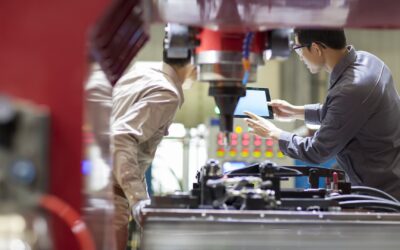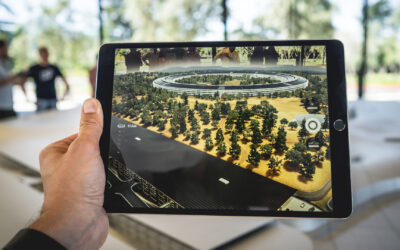Technologies like augmented reality (AR) are no longer just for games like Pokémon Go—businesses across almost every industry including manufacturing have found ways to increase their productivity with new technologies such as robotics, AR, virtual reality (VR), data visualization, and remote monitoring. While these kinds of innovations require an initial investment, they unquestionably pay off to increase ROI. Also, many manufacturers are finding that these technologies can be an effective way to address the industry-wide talent shortage.
AR and VR
VR places the user in a completely digitally simulated environment whereas AR maps digitized data onto real-world spaces. The manufacturing industry has begun to use AR/VR in a variety of ways to cut production costs, including quality control, floor planning, and inventory management, training with safe simulations, remote inspections or maintenance, and safety audits.
Need to onboard and train a new employee? AR tools like smart glasses can be used to show work instructions and guidance prompts real-time, within the employee’s field of view. For example, the glasses can superimpose each object that goes into the assembly of a unit and alert the user of errors or incorrect steps as each stop of the process is completed, which improves both productivity and precision. This technology can also help address the talent shortage by remotely connecting higher-skilled trades to instruct local technicians on the ground who offer a reduced rate of labor. Companies are finding that these capabilities are helping address the need for additional headcount, increasing productivity and reducing quality defects in a major way. Pretty cool…
Robotics
Automated manufacturing plays a major role in maximizing the efficiency and accuracy of the production process from assembling the raw materials to the packaging of the final product. Robots can perform repetitive tasks nonstop with a lower risk of error from fatigue than their human counterparts who are responsible for 23% of unplanned downtime in the manufacturing industry, totaling $50 billion in losses every year. Using robotics for riskier assembly that could be hazardous to humans also improves the health and safety conditions, resulting in fewer workplace injuries that cost the industry another $7 billion annually. The types of robots being used in manufacturing include:
- Collaborative Robots – Some human supervision is required, like exoskeletons
- Autonomous Mobile Robots (AMRs) – Uses artificial intelligence so no human inputs are necessary for tasks like warehouse order fulfillment
- Industrial Robot Arms – The most common flexible automation that can be programmed for a variety of repetitive tasks on an assembly line from surgery to flipping burgers
- Robots with Machine Vision – Machine vision empowers robotic devices like Aquifi’s 3D Fluid Vision to perform inspections for quality control which can otherwise be a tedious process and can even provide predictive maintenance information
- Robotic Blacksmithing – One of the newer forms of automation that uses arms, tools such as lasers that work with molten metal, and sensors to more efficiently shape materials that could replace 3D printing—a process that is wasteful of high-cost resources
Data Visualization
Data visualization software provides real-time reporting on manufacturing KPIs. It can help management monitor important metrics while the business is running rather than reviewing stale data and results at the end of the period when it is too late to take corrective action. Further, management can use this technology to identify and eliminate inefficiencies, prevent safety incidents and breakdowns before they even happen, and more effectively manage the end-to-end manufacturing process. Ultimately, this allows management to make data-based business decisions on the fly without having to walk the floor.
Remote Monitoring
By enabling remote access to track the real-time data, performance, and maintenance patterns of equipment—including emissions monitoring—it is possible to reduce the skills gap despite the ongoing labor shortage.
The Main Benefits of Tech in Manufacturing
- Maximizes production efficiency
- Cuts production costs without sacrificing accuracy
- Increases access to talent and offsets the labor shortage
- Replaces or supplements labor costs
- Reduces the costly on-the-job risks that come along with health and safety issues
- Assists with real-time processing that allows skilled employees to focus on other macro goals that will grow the business
Continue the Conversation
There are several resources available for companies beginning their Industry 4.0 journey. Visit the Michigan Economic Development Corporation’s Industry 4.0 landing page to take the Michigan Manufacturing Technology Center’s free technology assessment, Automation Alley’s Industry 4.0 Evaluation, or become an essential member of Automation Alley.
As a manager in the firm’s advisory & assurance department, Rob Cheyne focuses on managing financial and operational audits and reviews for closely held businesses, including project planning, oversight, execution and reporting. Rob joins the Clayton & McKervey team with over 12 years of accounting experience working with clients in the manufacturing & distribution, energy, financial services, professional services and real estate space. His broad experience ranges from local small and medium-sized businesses to international Fortune 500 companies. As a trusted advisor, Rob supports clients by delivering value, helping clients navigate industry and regulatory change, and identifying practical solutions to optimize business processes.




